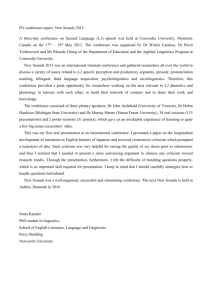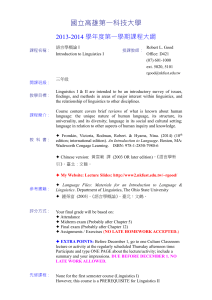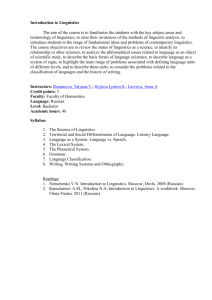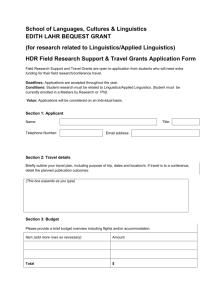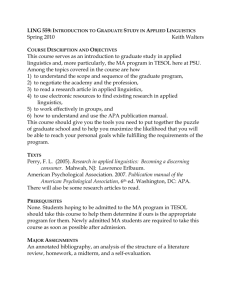Malamud Intro to Linguistics Lecture 1. What is Linguistics? 0. The
advertisement
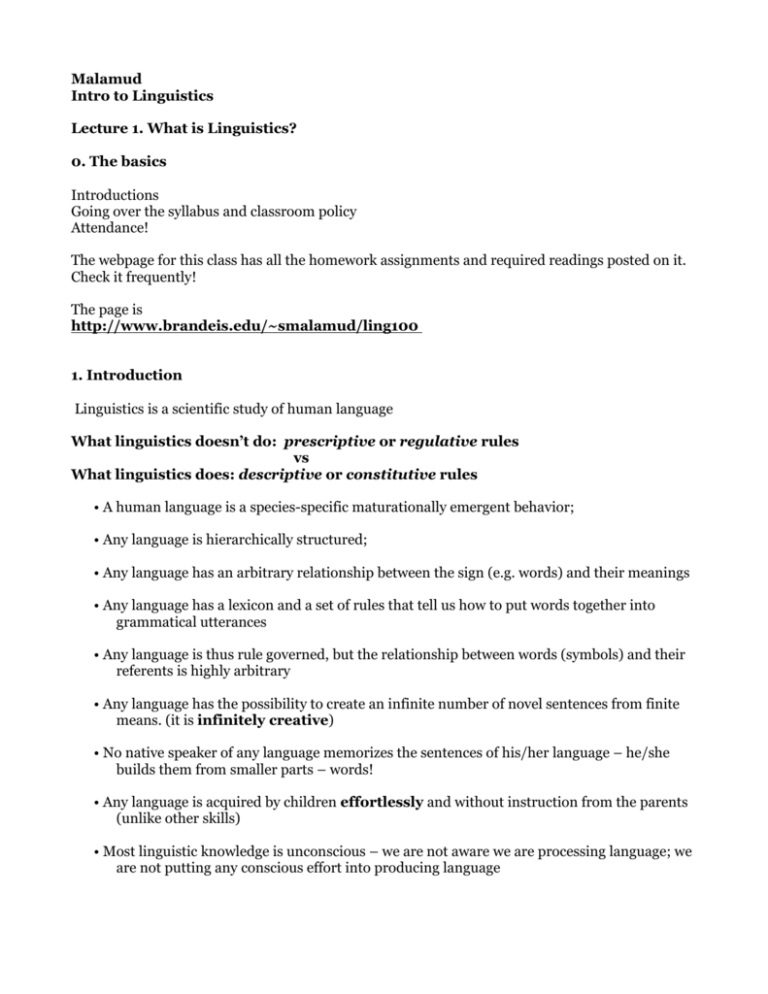
Malamud Intro to Linguistics Lecture 1. What is Linguistics? 0. The basics Introductions Going over the syllabus and classroom policy Attendance! The webpage for this class has all the homework assignments and required readings posted on it. Check it frequently! The page is http://www.brandeis.edu/~smalamud/ling100 1. Introduction Linguistics is a scientific study of human language What linguistics doesn’t do: prescriptive or regulative rules vs What linguistics does: descriptive or constitutive rules • A human language is a species-specific maturationally emergent behavior; • Any language is hierarchically structured; • Any language has an arbitrary relationship between the sign (e.g. words) and their meanings • Any language has a lexicon and a set of rules that tell us how to put words together into grammatical utterances • Any language is thus rule governed, but the relationship between words (symbols) and their referents is highly arbitrary • Any language has the possibility to create an infinite number of novel sentences from finite means. (it is infinitely creative) • No native speaker of any language memorizes the sentences of his/her language – he/she builds them from smaller parts – words! • Any language is acquired by children effortlessly and without instruction from the parents (unlike other skills) • Most linguistic knowledge is unconscious – we are not aware we are processing language; we are not putting any conscious effort into producing language • All native speakers understand and process language on the fly, in run-time, not after the fact. This will become particularly important in the discussion of sentence processing, especially as it relates to ‘garden path’ sentences • Language is produced spontaneously by children – need not be elicited by a stimulus! • All languages have a property of ‘displacement’ = can describe things that are not immediately present in the environment and are not elicited by some immediate stimuli. This is an important property of human language that distinguishes it from other animal communication systems • Variation among languages, while great, is not infinite – there are some principles, known as linguistic universals, that all languages obey • No language is ‘better’ or more ‘complex’ than any other language. There is no such thing as a ‘primitive’ language • Finally, we must distinguish between language and speech. A sign language is a language just like any other spoken language. It is a symbolic rule governed system capable of producing an infinite number of hierarchically structured sentences that are constrained in much the same way as those of a spoken language • No sign language is derivative from or based on a spoken language! 2. Linguistics and the Chomskyan Revolution Stimulus and response model of behavior including language e.g. Skinner 1957 (Verbal Behavior) Behaviorism – the study of behavior especially as it is elicited by stimuli/response. Chomsky 1957 (review of Verbal Behavior) and then also in Fodor, Bever, and Garrett 1974 (among others) – stimulus/response and association-formation mechanisms cannot explain the highly complex nature of language production, comprehension, and acquisition Since Chomsky 1957 linguists and psychologists began to seriously consider the idea that language is innately driven. We have a genetic (innate) predisposition towards language; we come equipped with a ‘blueprint’ for a language – any language – a skeletal structure onto which a particular linguistic knowledge is superimposed. Nativism and the Chomskyan revolution: nativism and behaviorism parallels the distinction between rationalism (Descartes) and empiricism (Hume). Rationalists emphasize innate factors in language development Empiricists emphasize the role of experience and nurture/data in language acquisition Poverty of stimulus – children acquire language without instruction; can produce novel utterances that are crucially not imitations of their parents language Example: The associative chain theory claims that a sentence is a chain of associations between one word and the next. Problem: structure-dependent questions, non-sensical sentences Colorless green ideas sleep furiously Also: Gawagai problem: how come the word is not associated with everything that’s present when the word is uttered? 4. Parts of Linguistics What do linguists study: a brief survey Linguistics aims to account for and explain the nature of Universal Grammar (UG) which is a system of principles, conditions and rules that underlie our knowledge of language, are common to all languages, and facilitate language acquisition in children (Chomsky 1975) • Phonetics – the study of the physical properties of the sounds of language. It has three major subparts – articulatory (how the sounds are formed in the body), acoustic (the properties of sounds as they travel in the air), and perceptual (how the sounds are perceived) phonetics • Phonology – the study of how sounds are put together; phonotactics – studies which sound clusters are permitted in a language and which are not • Morphology – the study of word formation; a morpheme is the smallest meaningful unit in a language, which crucially need not be a word (example: /s/ in bug-s has a meaning – plurality – but it is not a free standing word). /s/ is thus a bound morpheme; in contrast, /bug/ is a free morpheme – an independent word Bound morphemes can be inflectional – do not change the category of the word they are attached to, eg. /s/ in /bugs/ and derivational – can change the category of a word and/or create a significant meaning difference. Example: /tion/ in derive ~ derive-a-tion ; /un/ in known ~ un-known. • Syntax – the study of the hierarchical structure of sentences in the human language; what do we know when we know that a particular sentence is grammatical or ill-formed in our language? How are we able to understand and generate an infinite number of new sentences • Syntax studies the rules that underlie sentence formation and structure, things like word order variation and how it arises. We ask, which rules are universal and which are language specific? • Semantics – the study of meaning; how are the literal meanings of sentences composed from the meanings of sentence parts? • Pragmatics – how we use language, how context of utterances affects their meaning, how non-literal meanings arise This set of six categories -- from phonetics to pragmatics -- divides up the study of the linguistic system itself. Each category focuses on a different level of description and analysis. Speech communication depends on conventional connections between sound and meaning. To understand how it works, we need to describe and analyze the sounds, the meanings, and the words and phrases that connect them. Carving it up another way: • Theoretical linguistics (the nature of language) • Historical linguistics (how languages change; reconstruction of earlier stages) • Sociolinguistics (language and society) • Psycholinguistics (language in the mind and brain) • Applied linguistics (language teaching, translation, etc.) • Computational linguistics (computer processing of human language) ... and many others in this list... 5. Language vs. animal communication > no property of displacement – cannot talk about what happened yesterday > not spontaneous – cannot talk just about anything – constrained heavily by a purpose > is not as arbitrary as human language, though it does possess some degree of arbitrariness > not creative –cannot create complex “utterances” from discrete parts; it appears to lack a combinatorial system of generative rules that tell one how to compose bigger utterances from smaller parts HOMEWORK PREP: Passives and how to recognise them

